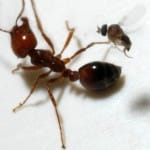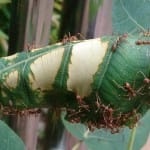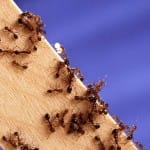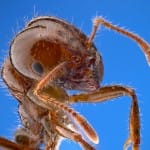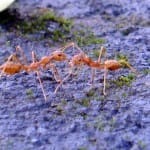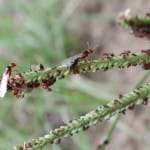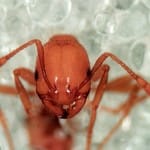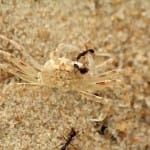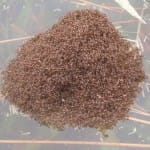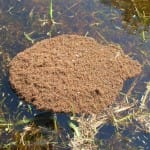Source(s): Beverly Sparks, Retired, Associate Dean of Extension, Extension Entomologist, The University of Georgia, College of Agricultural and Environmental Sciences.
However much you might wish it, fire ants are unlikely to disappear from the face of the earth. With a little planning and a lot of persistence, though, they can disappear from your yard.
The planning is simple; making fire ants get out and staying out requires only two steps.
The key, though, is persistence: this isn’t a one-time treatment; it’s a control program that takes diligence and determination.
The first step is to broadcast a bait insecticide over the entire area.
Fire ant baits consist of pesticides on processed corn grits coated with soybean oil. Two are readily available to homeowners (Amdro and Award).
The best time to apply a bait is in spring or fall, although you can apply them anytime when ants are actively foraging for food.
The best results, use fresh bait and broadcast it when the ground and grass are dry. If you use a hand-held seed spreader, set the spreader at the smallest opening and make one or two passes over the lawn at a normal walking speed ( the recommended rate is 1 to 1 1/2 pounds per acre).
The second step is to treat problem mounds with an approved product that kills the ants on contact. Treat these mounds no sooner than three days after you apply the bait.
Treat only the mounds causing immediate problems, such as those next to high-traffic areas such as sidewalks, play equipment or building foundations.
Most mounds that get only the slower action bait will eventually be eliminated, and leaving bait-treated mounds may actually help keep new fire ant queens from reinfecting the area as quickly.
To get rid of fire ant mounds with chemicals, target the queen and brood (egg, larvae and pupae) inside the mound. You can reach that target with drenches, granular products, dusts, liquid fumigants or injectable products.
Products such as acephate(Orthene), malathion and carbaryl(Sevin) are available as liquid concentrates for drenching fire ant mounds.
Drench mounds when the queens and brood are close to the surface (spring, fall, or after rain). Don’t disturb the mound before you treat it.
Dilute the product to the labeled rate and then gently sprinkle the solution around and then on top of the mound. If usually takes one to three gallons of the diluted solution to properly treat a mound.
Several granular products are labeled to treat individual fire ant mounds. To apply one, sprinkle the recommended amount on top of and around the undisturbed mound. Then water it in.
Products containing acephate (Orthene) are specially labeled for dusting fire ant mounds. To apply these products, evenly distribute the recommended rate over the top of each mound. You don’t have to water them in.
Some fire ant products (MC 96 Fire Ant Killer) contain methyl chloroform, a liquid that , when it is poured into a mound quickly volatilizes into a heavier-than-air gas that “fumigates” the mound. Ants inside are killed immediately, but ants out foraging won’t be affected. Plants around the treatment area maybe injured, though.
Products containing pyrethrin insecticides are made in aerosol containers with injection rods to reach deep inside the mound.
Fumigants and injectable products are expensive, but tend to be effective faster than mound drenches.
If you use this plan – broadcasting a bait, then treating problem mounds – expect greater than 90 percent of the fire ant mounds in the treated area to gone within 10-12 weeks.
However, the area will become reinfested by mated fire ant queens within six to twelve months if you don’t repeat the control programs on a regular schedule.
That’s where the persistence comes in.
To keep area free of fire ants, repeat the broadcast bait application every six months and then treat individual mounds as needed.
Center Publication Number: 9


